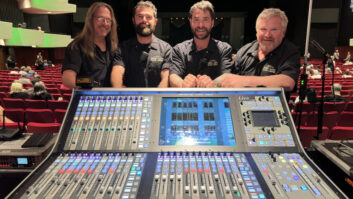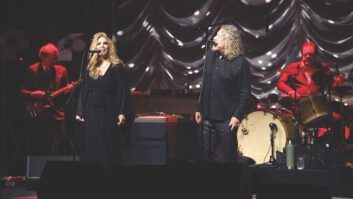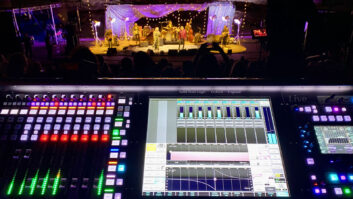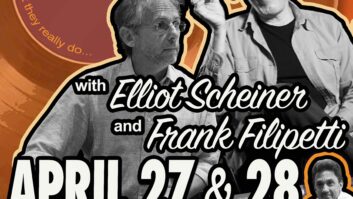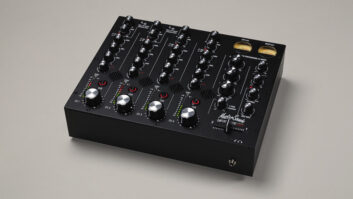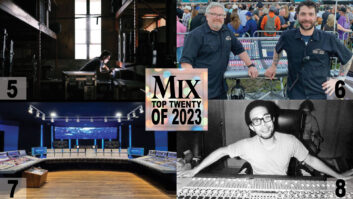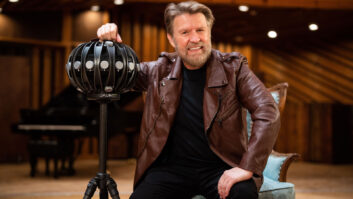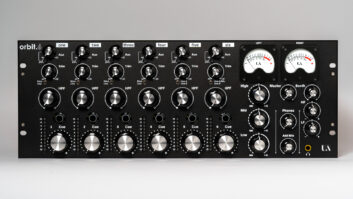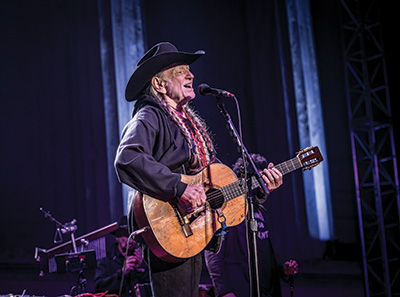
Willie Nelson is inarguably a bona fide American icon, and if Alison Krauss is merely a superstar in comparison, just give her a few more years to catch up. This makes both artists extremely popular touring acts, and the summer of 2014 found Nelson and Krauss and Union Station scheduled to tour together for 35 dates. A health issue caused cancellation of a handful of those shows, so they decided to reunite for nine shows in the summer of 2015. The final date with Nelson and Krauss and Union Station took place on Krauss’ 44th birthday at the Greek Theatre in Berkeley, Calif.
The tour carried its own consoles and processing and picked up stacks and racks locally. In Berkeley, Hayward, Calif.-based Sound on Stage provided an FOH system from L-Acoustics, comprising 10 V-DOSC line source elements per side for the main hangs, with three dV-DOSC cabinets under each for down fill. Side fill was provided by three ARCs constant curvature cabinets on each side, while four 8XT coaxial point-source cabinets along the lip of the stage supplied front fill. The system was driven by L-Acoustics LA8 units, which provide both system processing and amplification.
Nelson’s front-of-house engineer, Bobby Lemons, deals with one of the best-loved voices in American music. Nelson sings not into a high-end boutique mic, but a more modest Audix OM3 hypercardioid dynamic. However, Lemons babies the OM3 with a PreSonus ADL700 channel strip. Nelson liked the sound quality he heard after Lemons switched to the ADL700, while Lemons likes the sound quality of what he doesn’t hear. “The compressor is so transparent you don’t notice it’s there. I’m using more compression than it sounds like. I‘ll use 7 or 8 dB [of gain reduction] on [Nelson’s voice], and with anything else that would not be usable.”
Union Station’s vocals reflect the length of their time performing together. Jerry Douglas, the newest member, has logged only 18 years with the outfit, while the others are well past two decades. Union Station FOH engineer Chris West uses Shure SM58s for all four of the band’s singers and has no outboard processing; all mic preamps, compression, and EQ are onboard the DiGiCo console supplied by SE Systems of Greensboro, N.C., that he runs for the band.

Union Station’s final encore is a mostly a cappella version of “Down to the River to Pray,” a traditional American folk song popularized by Krauss’ version on the O Brother, Where Art Thou? film soundtrack. Krauss, guitarist Dan Tyminski (who voiced George Clooney’s performance of “Man of Constant Sorrow” in the film), and guitarist/banjoist Ron Block huddle around a Shure KSM44, while bassist Barry Bales borrows Douglas’ SM58 to sing the low part. To accommodate Bales’ deep voice, West runs the mic without the highpass filter he puts on the KSM44.
Nelson’s Family Band instruments are picked up with a combination of pickups and microphones. Trigger, Nelson’s famed nylon-string Martin acoustic guitar, is fitted with a Baldwin pickup and plugs into a Baldwin amplifier. The production carries a Steinway piano outfitted with a Helpinstill single-coil magnetic pickup that Nelson’s sister Bobbie plays. Kevin Smith’s electric bass runs through a Countryman 85 DI, while his acoustic bass has an Underwood pickup and a DPA 4099 mic mixed in a Vintage Revolution Acoustic Box live preamp. Drummer Paul English plays little more than a snare drum with an AKG C 414 above it and a Shure SM57 underneath. English’s brother Billy sometimes plays snare, but spends most of his time behind a percussion setup with an SM57 on shaker, Beyer OPUS 87 clip-on microphones for bongos, and a Crown SASS on chimes. Mickey Raphael holds a Beyer M160 for his harmonica.
Acoustic instruments are notoriously difficult to mike live, none more so than fiddle. If a mic is too close to the fiddle, it sounds harsh and scratchy, too far and the sound is swamped by bleed. West uses a Shure KSM9 on Krauss’ fiddle, and despite sitting no more than 24 inches above the instrument, the sound is smooth and even, not the least bit edgy.
Barry Bales’ bass is handled by a Shure Beta 98A with a bit of the DiGiCo’s onboard multiband compression to control low-end boominess. Tyminski’s guitar and mandolin are picked up with an AKG C 535 EB, as is Block’s guitar. Block plays his banjo into a Shure KSM313/NE ribbon mic.
Douglas, on the other hand, plays his Dobro through a full pedal board of effects, at the end of which sits a Fishman Jerry Douglas Signature Series Aura Imaging Pedal. The Aura pedal serves as a DI that feeds the sound system. (Block also has Aura pedals for his guitar and banjo, but West only uses them on dates where gain before feedback is an issue.)
For both acts, “less is more” is the order of the day, according to Lemons and West. With the one exception of Nelson’s voice, little compression is used on any of the inputs of either group. “One or two vocals will occasionally hit a compressor,” West notes, “but I don’t use a compressor on Alison’s voice because, to me, it doesn’t sound natural. I find fader movements do a lot better job on her vocal.” Nor do effects play much of a role in either band’s sound.
Thus, the biggest challenge Lemons and West cite is getting enough gain out of the microphones. “The whole thing is about gain,” says Lemons. “People ask me, ‘How loud are you going to be?’ and I tell them, ‘As loud as I can get it,’ which doesn’t mean it’s going to be that loud.”
“Gain before feedback is the hardest challenge for this show,” agrees West. “There’s a lot of really hot open mics for the guitars and vocals, and they play for finesse rather than output, which makes them so much better players. I would never ask them to play louder than they do because it would take away from their dynamics.”

West, who works as a system tech for SE Systems when he is not out mixing Union Station, says the gain-before-feedback issue impacts how loudspeaker arrays are hung, as well. “When we would have a P.A. hang that arced down too far onto the stage, I had a hard time getting a good 85dB mix out of it. [The shows average 85- to 97dB SPL.] So, I tried to advance shows to make sure that the hang did not hit the front of the stage and use front fills to hit the first three to five rows, if needed.”
While Lemons and West have similar “less is more” mixing philosophies, they diverge on their preferred tools. Lemons works on an analog Midas Heritage console, straps an Avalon AD2044 opto-compressor across the main mix bus to get more apparent loudness (both are supplied by Clair), and eschews effects altogether. “I have no effects at all,” Lemons states flatly. “I got tired of the way they sound, and I think [not using effects] makes you focus on what’s actually happening instead. You can’t just bury something in reverb.”
West uses a DiGiCo SD10 console, employing only the onboard EQ and compression, and a bit of reverb (a long, warm hall and a vocal plate). West chose not to use reverb at the Greek because of its steep, concrete architecture. During the show, West watches a SMAART display and occasionally uses a tablet to tweak EQ settings.
West’s setup serves as a sort of hub for the house, so he runs an analog output from his SD10 into a QSC RAVE 522UA processor, where it is submixed with the output from Lemons’ Midas console, from there to a pair of Lab.gruppen Lake LM-44 processors, then accesses the local sound company’s system at FOH. Where an FOH connection was not possible, West routed AES3 digital output from the Lake processors back into the SD10, using groups in the SD10 to get the signal to the SD rack onstage.
Mike Larcey, Union Station’s monitor engineer, works on another DiGiCo SD10, generating a stereo mix for each of the five band members and feeds it to their in-ear monitors (Sensaphonics for Krauss and Bales, Ultimate Ears for Douglas, and Shure for Tyminski and Block). On the whole, the players like to hear a mostly mono mix.

Because the channel count is relatively low compared to more amplified and highly produced acts (West uses 18 channels), Larcey and West share a single SD rack, dividing up the channels between them. This obviously simplifies routing between the monitor and house systems.
Nelson monitor engineer Aaron Foye supplies eight monitor mixes to Nelson and his family band, one per player except for Raphael and Bobbie Nelson, who each get two mixes. All of the monitors are Clair 12AM slant monitors, except for a Clair FF2-R placed in the crook of the piano for Bobbie.
Beyond the basics, both FOH engineers let their very seasoned clients do what they are so good at, making only occasional tweaks beyond the dialing-in required at the beginning of every set in a different venue on a different day. “Once you get a mix set up, if the band is doing their job, which Alison Krauss and Union Station always are, my job should be minimal movement,” West states. “You let them do what they do best and then just make minor adjustments here and there.”
Of course, the venue and location affect everything, West points out. “The Greek in Berkeley is an interesting place because it’s basically a stair-step that goes 180 degrees around and it’s very steep, so you can’t really take what you do at soundcheck too seriously. All of those reflective surfaces are going to change completely when people come in, plus there was a pretty good temperature change there, too; it got pretty cool that night.”
